Intertrigo: Photos, Causes and Solutions for Skin Fold Dermatitis in Dogs
Remember, this is an educational resource, not a guide for diagnosis.
Pictures are helpful, but they may not tell the whole dermatological story. We always recommend consulting with your vet for any of your dog's health concerns.
🎄 25% Off 🎄 Christmas Countdown Sale
Use code FELIZNAUGHTYDOG at checkout and get your dog, grand-dog, or your friend's dog the gift of relief!

What Is Skin Fold Dermatitis?
Skin fold dermatitis, also called intertrigo, frictional dermatitis, or skin fold pyoderma, is inflammation and/or infection between adjacent, contacting skin surfaces. It is considered a form of surface pyoderma, along with acute moist dermatitis (hot spots).
Intertrigo is typically classified by its location, and it can occur between facial, lip (perioral), neck, vulvar (perivulvar), scrotal, tail, or body folds.
Photo: Facial skin fold dermatitis on French bulldog, via r/ADM1277 on Reddit
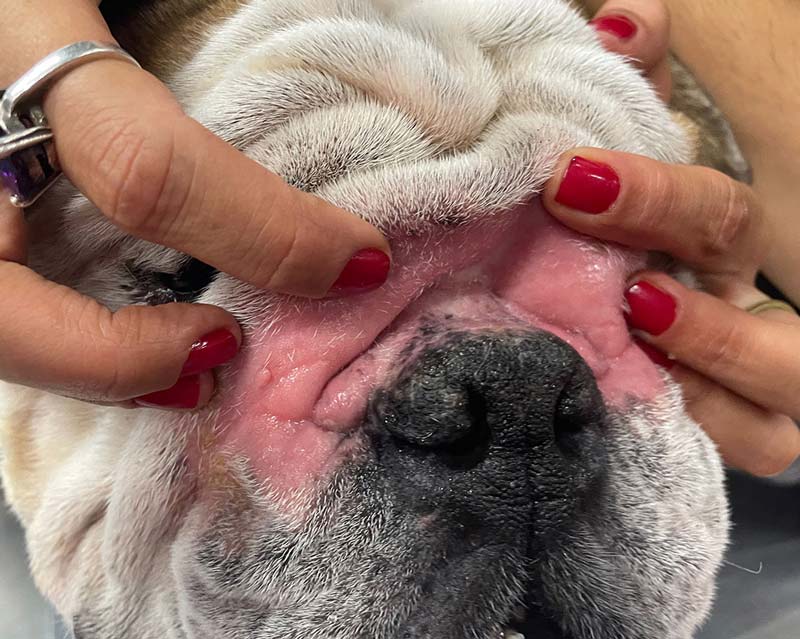
What Causes Skin Fold Dermatitis in Dogs?
Friction and lack of air flow between folds and wrinkles of skin creates damaged skin and a pristine location for bacteria and yeast to grow out of control, bringing inflammation and infection. Moisture that gets trapped in these crevices and concealed areas further enhances the microbes' growth.
Other factors that can contribute to canine skin fold dermatitis are parasites or skin allergies, whether seasonal, environmental, or food-related, and hormonal disorders.
Photo: Facial fold dermatitis on English bulldog, by Dr. C. Lorente, DVM; via Laboklin
-
This is a MUST for Frenchies! I have used this on my pup's entire body for so many issues. Worth EVERY SINGLE DIME!
-- Amber A.
Dog Breeds Prone to Skin Fold Dermatitis
As you might expect, breeds that are brachycephalic (short-snouted) or have wrinkly, drooping skin tend to be the ones that contract skin fold dermatitis the most. Obese dogs of any breed are also at risk.
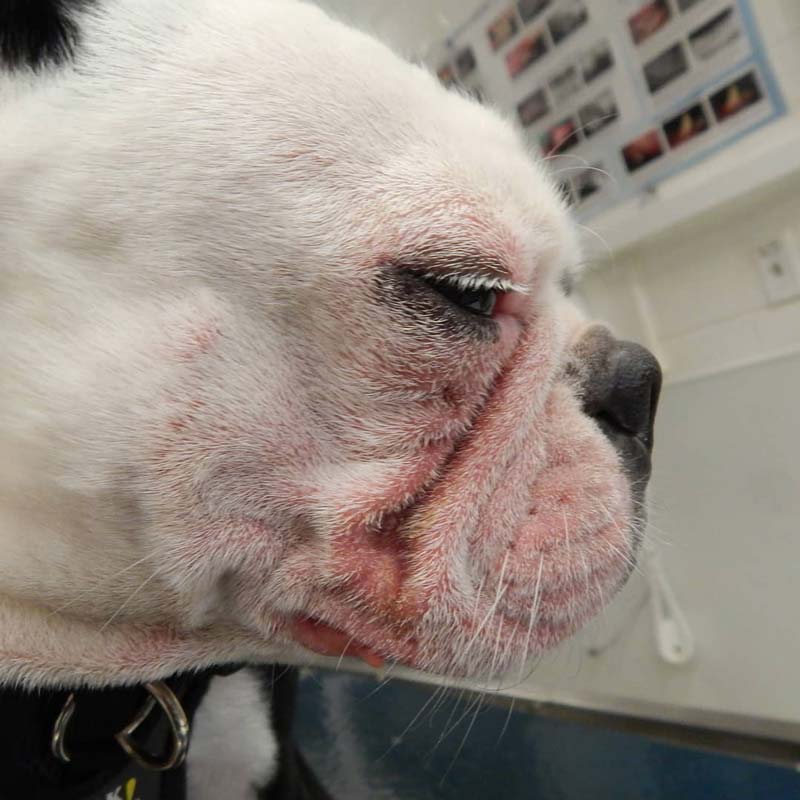
Types of Skin Fold Dermatitis in Dogs
Facial Fold Dermatitis
Facial fold dermatitis involves inflammation and irritation between wrinkles that is caused by friction and accentuated by trapped moisture, lack of air circulation, and allergies. This form of intertrigo primary affects brachycephalic ("smoosh-faced", to be technical) breeds, such as English bulldogs, French bulldogs, Pugs, and Pekingese.
As seasons change, or as a dog is exposed to an allergen, tear production often increases, and these run along the fold under the eyes and become trapped, as in this section's photo. Redness of the skin at the folds, hair loss, and bad odor are common signs of facial fold dermatitis.
If left unchecked, pyoderma (bacterial infection) and yeast infection (Malassezia) will set in. This is an area where Lavengel® can be of great use to soothe the irritation, help reduce inflammation, and counter infection.
Photo: Nasal skin fold dermatitis, via Dr. Kraemer Vet4Bulldog on Facebook
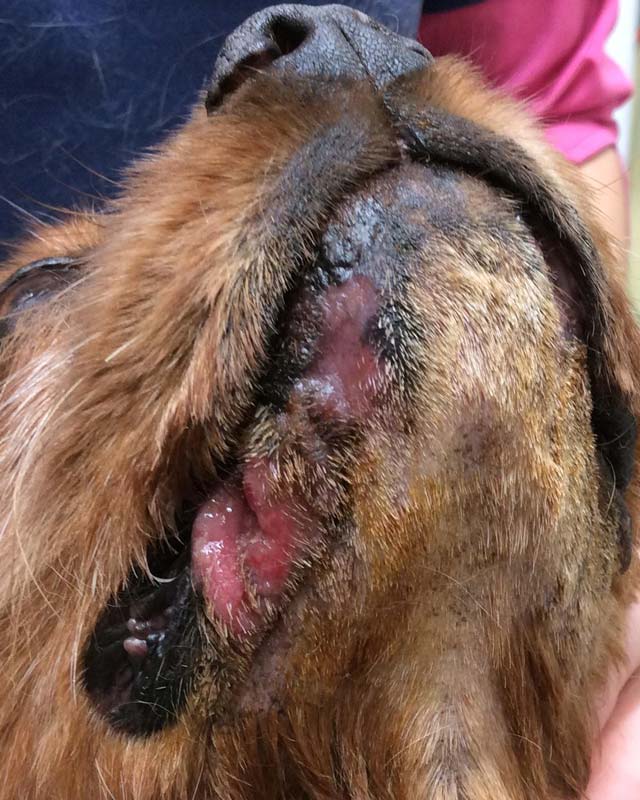
Lip Fold Dermatitis
Lip fold, or perioral, dermatitis tends to affect breeds with large lip flaps (jowls), such as Saint Bernards, Spaniels, Boxers, and Basset hounds. The constant rubbing along with trapped saliva promotes microbial growth, which in turn leads to inflammation, redness, and infection.
Yeast and bacterial overgrowth and infections are very common with lip fold dermatitis. Further signs can be red, pink, or dark patches along the upper and lower lips, as well as really, really dank breath (halitosis).
Photo: Lip fold dermatitis on brown spaniel; via Blayney Veterinary Hospital on Facebook
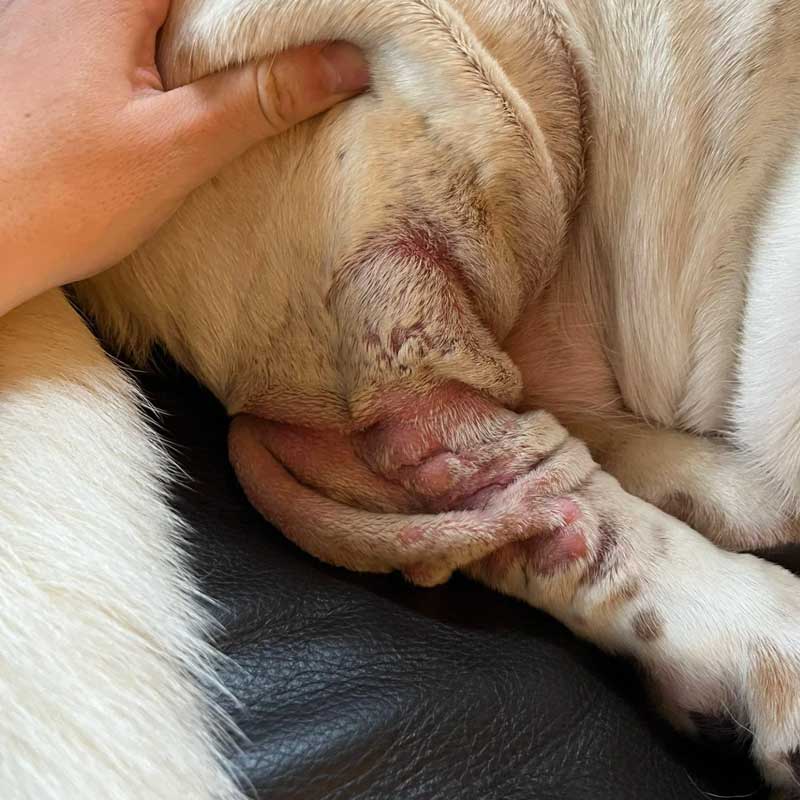
Neck and Body Fold Dermatitis
Neck and body fold dermatitis tend to harass breeds that carry pendulous dewlaps (a great phrase for "big, hanging neck folds") and large amounts of wrinkles, including basset hounds, bloodhounds, Newfoundlands, and Chinese Shar Peis. Breeds that salivate exceedingly or swim regularly are at risk for moisture getting trapped in skin folds.
Body fold dermatitis can also come into play for other breeds if they are obese. As with any form of dermatitis, yeast infections (Malassezia) can get established and create a mighty itch, hair loss, pinkish skin with dark patches (hyperpigmentation) and a musty odor.
Photo: Hind leg skin fold dermatitis with likely yeast infection, via r/Blueyintheus on Reddit
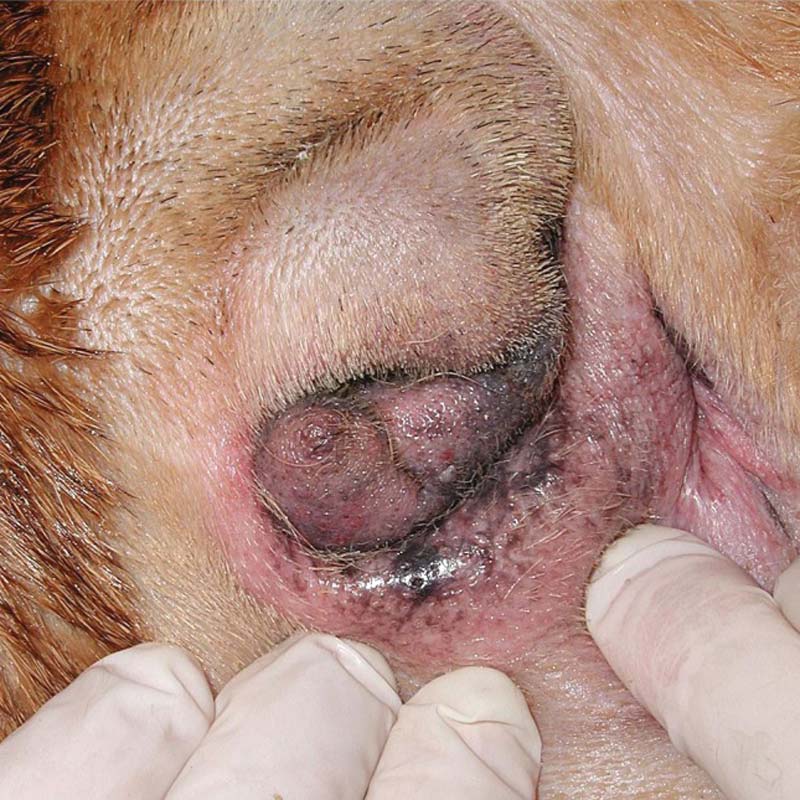
Tail Fold Dermatitis
Tail fold intertrigo involves dogs with corkscrew tails, especially in English bulldogs, Boston terriers, and pugs. The tightly curled tail can grow inward and/or create pressure on the surrounding skin, creating irritation and almost inevitable infection.
Tail fold dermatitis can cause intense itching, and dogs will rub the area in order to relieve the irritation. Many dogs actually require surgery to remove the crooked tail bone, which makes the area easier to keep clean.
Photo: Tail fold dermatitis due to in-grown screw tail of English bulldog; via ResearchGate
Scrotal and Vulval Fold Dermatitis
Whole male dogs (i.e., still possessing their jewels) are at risk for developing dermatitis around the scrotum and groin, especially if they are obese or possess sagging skin. Skin allergies, confined moisture, and parasitic bites can be culprits that bring about the initial irritation.
Vulval fold dermatitis can affect female dogs that: 1) are spayed before their first season with an inverted vulva; 2) have whelped (had puppies), are older, and have an enlarged, flaccid vulva; 3) have urinary tract disease and overclean the vulval area, creating irritation.
For both genders, the surrounding skin will appear red and inflamed, and the dog will likely be licking or dragging the area in order to relieve itching.
Symptoms of Skin Fold Dermatitis in Dogs
- Redness and inflammation in and around the skin fold; hot spot(s) possible
- Skin fold appears moist or dark with crusts at edges
- Hair loss within and without fold
- Foul or musty odor - often sign of yeast (Malassezia) infection
- Pustules with yellow or white discharge in and around area - typical of pyoderma (bacterial infection)
- Itching (pruritis) or pain around the area
- Excessive licking, pawing, scratching, or rubbing; dog won't leave the area alone
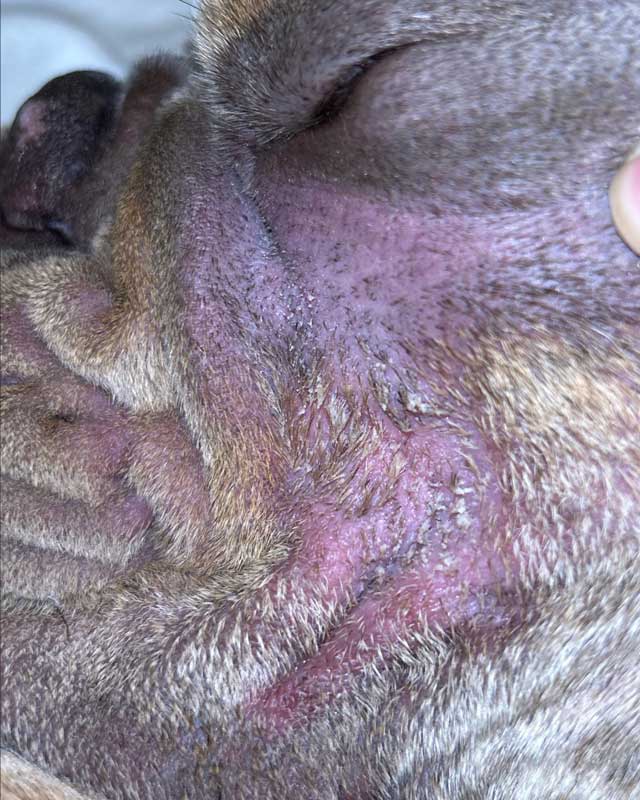
How Is Skin Fold Dermatitis Treated?
Treating skin fold dermatitis generally begins with a veterinary examination of the area and a cytology - microscopic evaluation of a skin sample. Your vet will also go over your dog's medical history and inquire about allergies.
Intertrigo is typically treated with topical products, beginning with the removal of soiled hair and cleaning the area(s) with topical antiseptics in the form of wipes, sprays, or shampoos. These products typically contain an active ingredient that is antibacterial and/or antimycotic (antifungal), such as chlorhexidine (2-4%), acetic acid, boric acid, or benzoyl peroxide.
At first, the area will have to be cleaned and sanitized daily with the prescribed topical treatment, which will be based on the cytology results. As the irritation and infection clear, this cleaning may be reduced to twice weekly. For severe infections and recurrent allergy dermatitis, prolonged topical therapy along with oral or injected steroids may be utilized to reduce inflammation and mitigate allergies.
In certain cases - as in tail fold dermatitis, chronic, persistent cases, or if the dog cannot tolerate topical therapy - surgical removal or reduction of the skin may be required.
Photo: Facial skin fold dermatitis, via r/ImpressionFew631 on Reddit
Caring for and Preventing Canine Skin Fold Dermatitis
The best way to prevent skin fold dermatitis is to keep an eye on your dog's skin folds, clean them regularly, and make sure they are dry. If you notice redness or your dog licking, scratching, or rubbing the area consistently, examine it closely, give the area a thorough cleansing followed by a topical ointment like Lavengel®. If the problem persists, take them to the vet.
On top of that, you'll want to understand and stay on top of your dog's allergies. Allergies are a principal culprit behind most forms of dermatitis, and they are instigated by changes in season, the dog's environment, or a reaction to their food.
Finally - yes, we're going to say it again - Lavengel® can be a big help with skin fold irritations and dermatitis. Its powerful, research-backed formula soothes itching and discomfort, counters bacteria and yeast, and helps heal the damaged skin - all while being safe if your dog ingests it.
Dog Skin Fold Dermatitis FAQs
Will skin fold dermatitis resolve on its own?
While it is possible, it is not likely, especially if there is an overgrowth of yeast and bacteria. These infections cause itch and discomfort that, when scratched and licked, only exacerbates the problem.
Simply cleaning your dog's skin folds and wrinkles regularly, and ensuring they are dry after bathing or being in water will go a long way in preventing skin fold dermatitis.
Why do my dog's wrinkles smell bad?
The stench comes from an overgrowth of bacteria and yeast. If anything, the worse the smell, the more likely there is an infection that should be treated promptly.
Some of the microbes that contribute to the bad smellscape are:
- Proteus vulgaris (bacteria)
- Pseudomonas aeruginosa (bacteria)
- Staphylococcus pseudintermedius (bacteria)
- Malassezia pachydermatis (aka yeast, a fungus)
It is possible for both a bacterial infection and yeast infection to be present at the same time. Thus, it's vital to go see your vet if you suspect (or smell-spect) an infection.
Interesting side note: Proteus and Pseudomonas are chiefly responsible for "frito feet" in dogs.
What should I clean my dog's skin folds with?
Chlorhexidine wipes are a solid, relatively inexpensive choice for cleaning and sanitizing canine skin folds. Always be careful when using them around their eyes.
For cases where yeast is present, look for wipes that contain anti-fungal "azole" ingredients (miconazole, ketoconazole, enilconazole, etc.).
If you're looking to clean facial and lip folds, be sure to look for those that are safe to use on sensitive skin, near the eyes and mouth, and low- or fragrance-free.
We would certainly recommend following up cleaning the folds with an application of Lavengel® to promote relief and healing while protecting from microbial growth. Use caution when using it around the dog's snout, as it does have a strong lavender scent when first applied (it dissipates quickly after application).
Here are a couple of home remedies for cleaning dog skin folds we've run across:
- Cotton wool pads soaked in saline or salt water
- Normal domestic vinegar diluted 50:50 with warm water has some antibacterial effect. HOWEVER, this solution can burn if there are open lesions, and it due to the strong smell, it must be used with care around the nose.
How often should I clean my dog's skin folds?
For regular maintenance, cleaning your dog's skin folds once each day or every other day is recommended.
It is equally important to make sure their wrinkles are dry after cleaning.
However, they should not become overly dry, as this can lead to microscopic cracks in the skin that bacteria and fungi can invade. Thus, it's good to use a moisturizing oil or balm after cleaning and ensure that your dog's diet is rich in omega-3 fatty acids.
Is there a certain way to bathe a wrinkly dog?
Regular bathing is another key to keeping those wrinkles free from intertrigo.
- Be sure to use a mild or hypoallergenic shampoo. There are shampoos out there that are made for wrinkly barkers.
- Use a sponge or loofa to get in and around those skin folds.
- Rinse them twice, making sure that all of the shampoo has been rinsed off. Shampoo residue is not your friend.
- Dry them off thoroughly, with extra care in removing the moisture from between skin folds. A microfiber dog towel may prove more useful than a traditional bath towel.
How do dog wrinkles get so dirty and rashy?
There are several reasons that dogs' skin folds get irritated, but here are 4:
- Wrinkles create pockets that catch and hold dead skin cells, shed fur, bits of food, dust, and dirt.
- These folds are also, by nature, warm and moist, so bacteria and yeast dwell there naturally.
- The folds are constantly rubbing against each other, slowly eroding the skin and allowing the microbes to overpopulate the area.
- Allergies can further irritate and inflame the skin, drawing the immune system's attention and allowing the microbes to grow unchecked.
Natural Dermatitis + Rash Relief Ointment for Dogs
Sale Price with Code: $14.25
Lavengel® is a relieving cream for canine dermatitis, allergy rashes, irritations, infections, and hot spots. Its concentrated formula is safe for dogs to lick and made in the USA.
25% off! Code FELIZNAUGHTYDOG
Free standard shipping on orders over $35
30-day money back guarantee
For every unit sold, we donate to help dogs + heroes








More Canine Skin Conditions
-
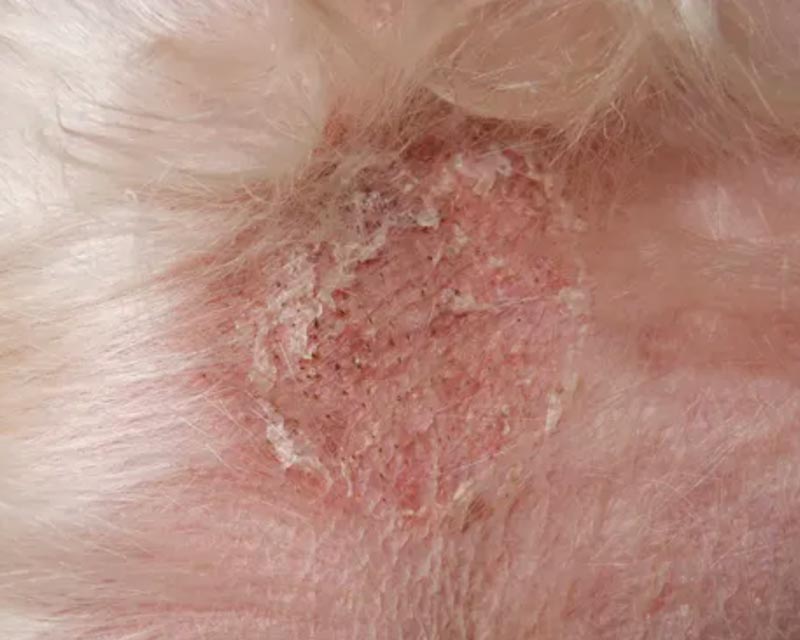
Ringworm
Not a worm, but a germ?Despite the name, ringworm is not a parasite, but fungus caused by three different species. It can even be spread to and from humans.
-
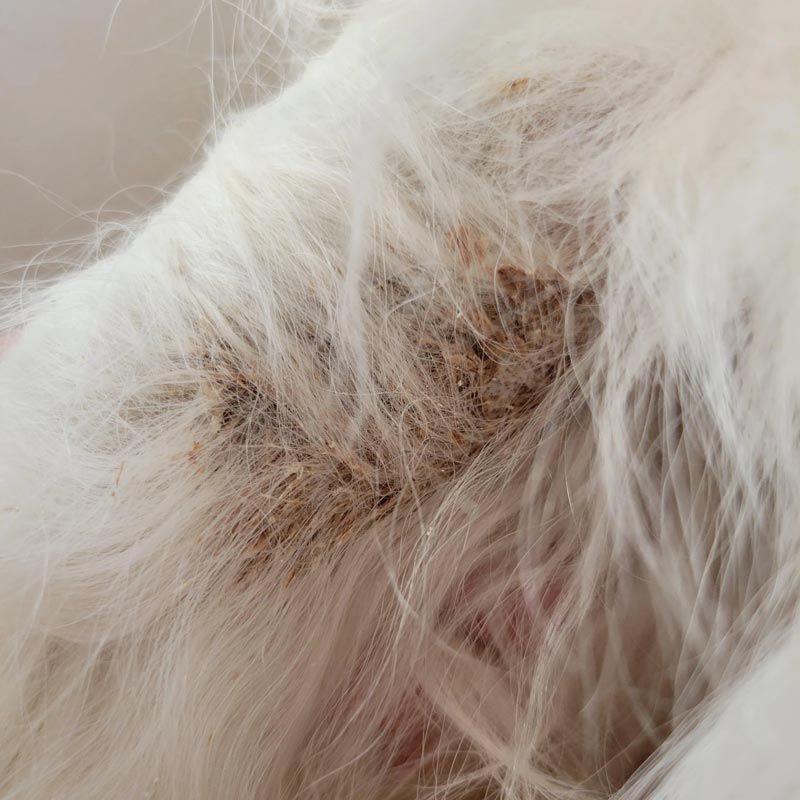
Seborrhea
In dog we crustSeborrhea is a condition involving thick dandruff and greasy brown-yellow crusts caused by an overproduction of keratin.
-
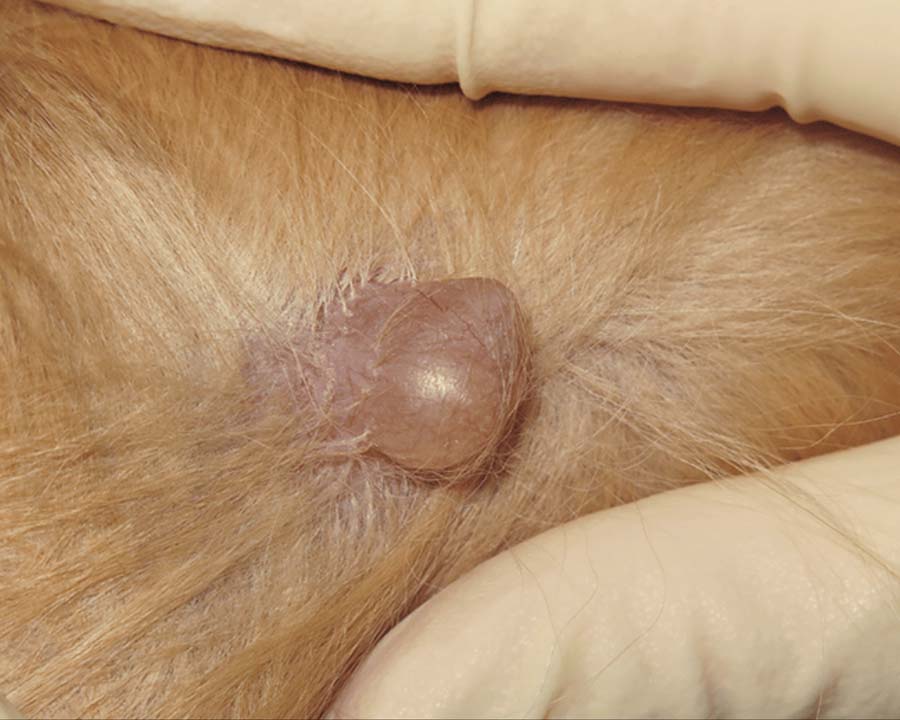
Cysts
Re-cyst-ance is futileCysts are pockets of semi-fluid matter that reside under the skin. They are typically benign, but there are instances where removal is needed.
Collapsible content
Resources on intertrigo + skin fold dermatitis
Dan G. O'Neill, Dara Rowe, Dave C. Brodbelt, Camilla Pegram, Anke Hendricks; 2022: Published by: Scientific Reports, July 6, 2022, 12(1):10553; PMID: 35794173; PMCID: PMC9259571.
Other Resources



